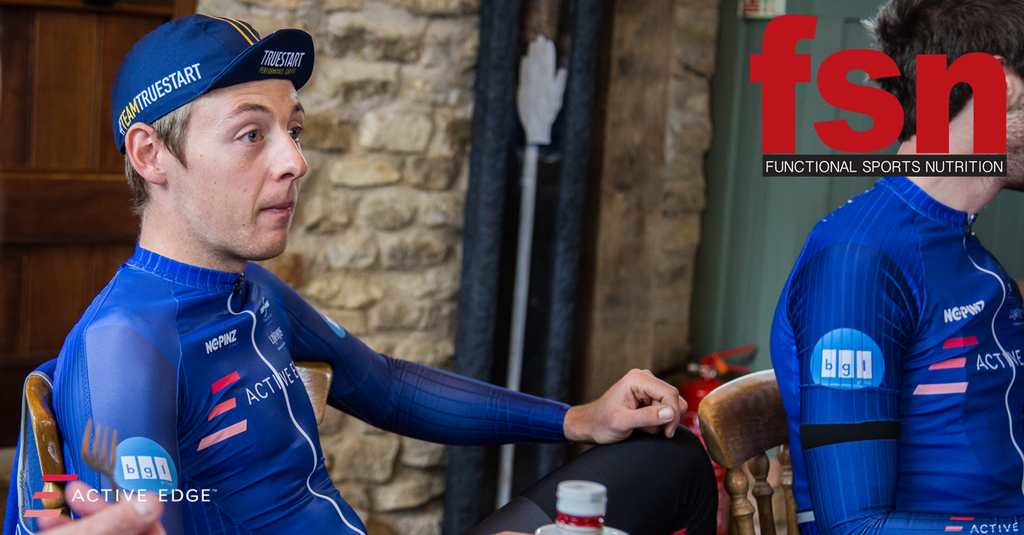Article featured in Functional Sport Nutrition Magazine March/April 2018
Samuel Woodfield is a 27 year old, Cat 1 rider and a key figure in the formation of the new Active Edge Race Team for the 2018 season. The team aims to compete at the next level this season by competing consistently at National B races, attending Premier events across the UK and Ireland and taking four riders to compete in the Masters Tour of Chiang Mai in Thailand. We asked him a few questions.
Hi Samuel, thanks for chatting to us. Congratulations on putting together the new Active Edge Race Team for the 2018 season. Can you tell us more about the team?
SW: The team is comprised of three 1st Category riders, including one rider who has moved all the way from New Zealand to join the team for our summer; four 2nd Category riders, one female rider, and one triathlete, who is aiming to take part in some 4th Category road races. The main aim for the 2nd Category riders is to be at the front end of the East Midlands Road Race league and the 1st Category riders will be looking to participate in major National B events all over the UK, whilst also taking part in some of the more prestigious elite races.
For our readers who don’t normally follow road cycling, which stage of the periodised year are you now in and what kind of training are you most focused on?
SW: I am currently in a large endurance-based training block, which is the building block for the rest of the season. Within this period, I focus on strength endurance (over-geared efforts), sprint drills and high cadence efforts. I will look to move into higher intensity intervals over February/March, with the aim to start racing towards the end of March in Ireland.
Would you mind sharing a sample day’s diet with our readers?
SW: Breakfast: Overnight oats with fruit, Greek yoghurt, berries, nuts, seeds, one square of 100% dark chocolate, plus tow eggs if riding for over three hours. And lost of coffee!
Training: 500ml of fluid per hour, 30-60g of carbohydrates ingested after 90 minutes and then every 90 minutes if riding for over three hours (in the form of bananas, gels, dates, bars and fruit pastes).
Post-workout: Chocolate milk, a handful of nuts, peanut butter, spinach, BlueberryActive. I’ll switch the BlueberryActive for CherryActive if the workout is high-intensity.
Lunch within 90 minutes of finishing training: Omelette, sweet potato, avocado, lost of green vegetables, yoghurt with berries and one square of 1005 dark chocolate.
Mid-afternoon snack: Yoghurt, fruit, nuts and honey. If the following day is a rest day, i might swap this for a high-protein snack, such as two eggs and 50g of nuts.
Dinner: It is the same as lunch expect that i’ll normally have a poece of fish or lean venison instead of eggs. Then yoghurt with fruit, peanut butter and one square of 100% dark chocolate.
Bedtime snack: Yoghurt, peanut butter CherryActive concentrate, casein and a banana if training the following day.
Being part of Active Edge, which products fo you currently use to help with your training and why?
SW: I am currently using the CherryActive concentrate to aid recovery after the strength-based sessions, whilst also mixing it with yoghurt and protein powder just before bed to aid sleep.
Moving more towards the season, I will be incorporating the BeetActive concentrate into my regime to help me with the high-intensity and threshold-based sessions due to the high concentration of dietary nitrates. I will go through a ‘loading phase’ in the build-up to my races.
Finally, I use the BlueberryActive concentrate in a number of different recipes. I add it to my bircher muesli in the morning for flavour and also add it to smoothies and yoghurt through the day to bring more variety into my diet.
We’ve read that you suffered from orthorexia, which started as a quest to drop weight for competition. Can you tell us a hit more about your struggles and what have you learned since then?
SW: Due to the nature of sport, I became obessed about achieving the perfect power-to-weight ratio. I switched from focusing on performance and just focused n dropping with in body fat, thinking that my power would remain the same regardless of my weight and fuelling strategies. Unfortunately this developed into a poor relationship with body weight and food.
I then enlisted the help of Renee McGregor, author of Orthorexia: When Healthy Eating Goes Bad. We came up with a very sensible fuelling strategy for both life an training. We slowly started to reintroduce carbohydrates into my diet, which was a massive step forward. Over time, this helped rebuild my metabolism and achieve the body composition that i really wanted, but in a sensible and healthy fashion.
The other positive side of correct fuelling is the huge benefit it’s had on performance. My current numbers are better than ever and I am also feeling healthier and more energised. I have also learnt not to believe everything I see on social media when it comes to fuelling, eating and dieting.
______________________________________________________________________________




